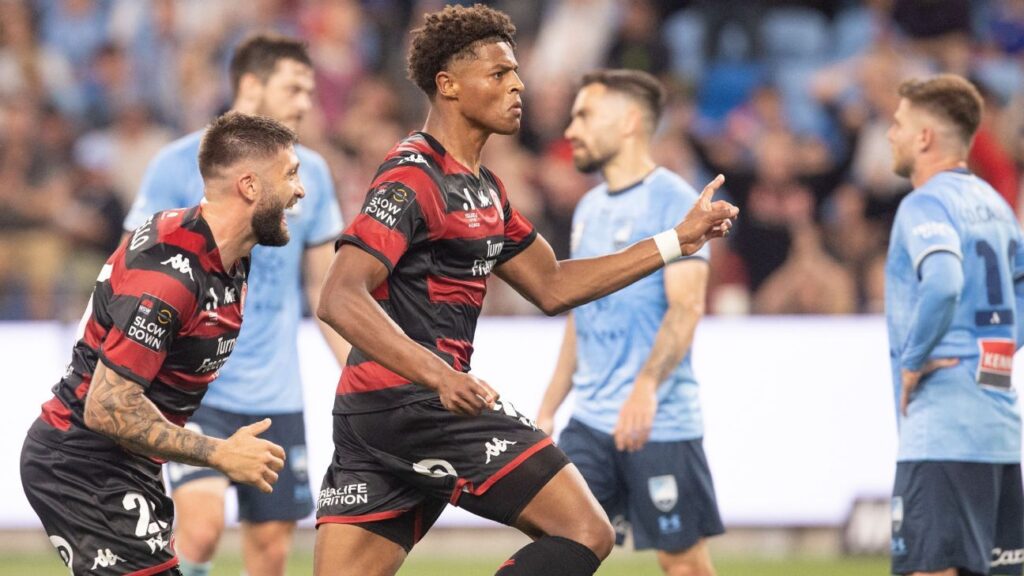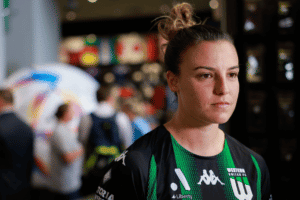
In a season built around rejuvenation, the in-house produced A-Leagues All Access has led the way for the Australian Professional Leagues (APL) in 2022-23.
A-Leagues All Access – a key part of the APL’s strategy to start to win back the disenchanted many left alienated by the previous administration – was set to debut as a flagship offering under the APL’s first full season in charge of the A-Leagues (2021-22). However, as has been the case since 2019-20, COVID-19 delivered disruption in spades, and the APL were forced to shelve the project until now.
The series is presented week-to-week in a fly-on-the-wall manner akin to Amazon’s ‘All Or Nothing’ show, except in comparison A-Leagues All Access delves into the experiences of one individual’s actions on matchday and the broader impact of their influence on the team. So far, the series has given fans insight into Central Coast Mariners starlet Garang Kuol, Sydney FC detractor Milos Ninkovic, and Chloe Logarzo’s role at the heart of the debut Liberty A-League campaign for Western United women’s.
Accumulating more than 2.2 million video views and over 4.6 million social media impressions (as of November 23), the success of A-Leagues All Access thus far is reflected in the correlation between the aforementioned video views and social media impressions and transition of interest onto free-to-air (FTA) broadcasts of the A-League Men, with the APL confirming a 33% growth in FTA viewership between episodes 1 and 4 of A-Leagues All Access.
The reception alone is an indicator of eyes and ears being pulled towards the sport, as well as the hearts and minds being won back by the APL.
Speaking with Soccerscene ahead of the restart of the A-League Men’s season, APL CEO Danny Townsend explored why exactly A-Leagues All Access is resonating with fans, the motivations behind the series, and how the series provides football with an edge over the rest of Australia’s competitive sporting landscape.

Why do you feel that A-Leagues All Access has resonated with Australian football fans?
Danny Townsend: Well, I think at the end of the day football fans want to look under the hood and see what goes on. Watching 90 minutes of football can be compelling but really getting to understand the behind-the-scenes ongoings they’re not accustomed to seeing is something that I’m sure has driven a huge amount of the interest in A-Leagues All Access.
When you’re close to the action as someone who works in the game you take it for granted, but when you’re a fan on the outside and you’re not accustomed to seeing it, it really brings to life that experience of being inside of a dressing room or board room, or at a training ground. But more importantly when you’re watching the game unfold over 90 minutes you can connect those things together and get a full experience.
It feels like A-Leagues All Access is connecting fans to the leagues in a way they’ve always craved for. How significantly did re-engaging disenchanted fans play into the motivations behind A-Leagues All Access?
Danny Townsend: The APL has an overarching strategy that has three key pillars to it – one being how do we re-engage our core fans who’ve drifted particularly with COVID making it so difficult to give them certainty around when matches are played; that really affects your core more than anything else.
Our second pillar is looking at how we grow new audiences and the All Access program serves both. It serves to re-engage our core and gives them another reason to reignite their interest in their clubs or their players, and for new fans who haven’t watched the A-Leagues before, it maybe exposes them to some interesting content that draws them into it.
Finally, our third pillar is to grow the capabilities of our clubs and equally a lot of the content we’re creating through the capturing of All Access is finding its way to club socials, which is driving a lot of engagement there. So, it’s really designed to serve all three pillars of the APL’s strategy.
Obviously, A-Leagues All Access captures the unpredictable nature of football and more broadly, live sport. Why do you feel the series gives an edge to football over the other codes?
Danny Townsend: We’re not a sport that has 60 scoring opportunities in the actual match itself. The euphoria around goals being scored is limited in our game but when they are scored, they’re celebrated, but there is so much more to it. It drives excitement as you see the coach and how they’re engaging with their players, it shows how players are reacting to certain circumstances in the dressing room – those things are all heightening the experience for a fan. And if we can bring fans as close to live as we can that’s only going to bring them closer to our game.
If you look at other fly-on-the-wall documentary series’ like ‘The Test’ for cricket, it was launched over a year after the period it documented. Formula One ‘Drive to Survive’ is a retrospective look at the season that’s already gone and everyone that’s watching knows what’s already happened on the grid. Whereas with what we’re embarking on with A-Leagues All Access it’s live; it’s in the now; it’s basically bringing to life the match on that weekend and driving interest into next weekend’s match.

How is the series coordinated? Is the whole season mapped out or is it organised on a week-to-week basis?
Danny Townsend: We looked at the first six weeks to start with because we had some fairly predictable stories that would surface such as the Ninkovic example which was always going to be one that the fans would want to get in behind. Nani’s first game was an obvious one at the new stadium in Sydney that we wanted to follow. And Chloe Logarzo’s was her first game returning from injury at a new club in pursuit of being a part of the Matildas at next year’s World Cup.
So, there are certain ones we’ve identified throughout the 30 weeks that we’ll be going after and there’s ones we’ve left open. As stories evolve throughout the season based on the ebbs and flows of competitive sport there’ll be stories that unfold that we don’t know of yet that will be part of the 30 episodes.
Will the A-Leagues All Access series be looking to expand beyond players and coaches to potentially highlight fan groups such as the team at RBTV or any of the active support groups?
Danny Townsend: Absolutely! There’s only so many dressing room sprays that you want to put on air before they get boring.
But on a serious note, we’ve got so many colourful stories in our league from the fans to even the administrators and how decisions are made around clubs. There’s just so many different components of the A-Leagues that we want to bring to life. Obviously, you start with players because they’re the stars of the show and coaches are major contributors to the game. But as you move through those stakeholder groups, there’s certainly interesting stories in there and fans are certainly going to be a focus in upcoming episodes.
Has there been an onward effect in terms of viewership of and engagement with TV and Paramount+ viewership since the series started?
Danny Townsend: Absolutely. We’ve looked at it through two lenses: how do we drive full episode viewing on any of the platforms it’s on (KEEPUP, Paramount+, 10Play, YouTube) but also just as important is the social reach that we’re generating from it. The clips and the cut-up short-form content that we’re distributing has been enormous and has so far accumulated over three million views, which for Australia and our game is enormous. That’s building every week as it becomes more appointment viewing for people waiting for Thursday night for the next episode to drop and that’s something we expect to continue.
For mine, A-Leagues All Access is only one part of a broader content strategy for KEEPUP Studios. We’ve launched All Access with KEEPUP Studios but you’ll start to see a lot more content alongside our podcast series’ that have been coming out – I think our current podcast is the number one in football at the moment and that’s going to continue to build. And from a video standpoint you’ll be seeing more original content being developed by the APL and KEEPUP Studios, and as the season rolls out there’ll certainly be more shows to engage A-Leagues fans and football fans in general, so, watch this space!






















